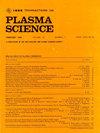带不同口径线圈发射器的混合电枢效率研究
IF 1.3
4区 物理与天体物理
Q3 PHYSICS, FLUIDS & PLASMAS
引用次数: 0
摘要
提高效率是线圈发射器领域的一个主要研究领域。线圈发射器分为磁阻线圈发射器和感应线圈发射器两种。磁阻线圈发射器使用铁磁衔铁,由于衔铁的磁饱和度和密度较高,其直径一般较小;而感应线圈发射器使用导电衔铁,其直径一般较大。为了提高线圈发射器的效率,本文提出了一种用于线圈发射器的混合衔铁结构,其中铁磁衔铁的前端置于线圈的末端,并通过长度为线圈一半的绝缘材料与导电衔铁相连。为了比较混合电枢与原始电枢的效率,选择了孔径分别为 11.8 毫米、18.4 毫米和 50 毫米的三个线圈发射器来模拟不同参数下的混合电枢,并验证混合电枢模拟与实验的一致性。最终结果表明,在孔径为 11.8 毫米时,铁磁电枢的效率优于混合电枢。在 18.4 毫米孔径时,混合电枢的效率为 9.12%,比原来的铁磁电枢提高了 4.08%。在孔径为 50 毫米、电压为 1000 V 时,混合电枢的最佳效率为 3.17%,与带负载的同质量铝电枢相比提高了 2.73%;在电压为 2000 V 时,混合电枢的最佳效率为 7.87%,与带负载的同质量铝电枢相比提高了 5%;在电压为 3000 V 时,混合电枢的效率低于直接带负载的铝电枢。这些发现为提高线圈发射器的效率提供了新的有效思路。本文章由计算机程序翻译,如有差异,请以英文原文为准。
Efficiency Study of Hybrid Armatures With Coil Launchers of Different Calibres
Improving efficiency is a major area of research in the field of coil launchers. Two types of coil launchers are the reluctance coil launcher and the induction coil launcher. Reluctance coil launchers use a ferromagnetic armature, which is generally smaller in diameter due to the armature’s magnetic saturation and higher density, while induction coil launchers use a conductive armature, which is generally larger in diameter. To improve the efficiency of coil launchers, this article proposes a hybrid armature structure for coil launchers in which the front end of the ferromagnetic armature is placed at the end of the coil and connected to the conductive armature by an insulating material half the length of the coil. To compare the efficiency of the hybrid armature with that of the original armature, three coil launchers of 11.8, 18.4, and 50 mm bore were selected to simulate the hybrid armature with different parameters and to verify the consistency of the simulation and experiment of the hybrid armature. The final results show that the efficiency of the ferromagnetic armature is better than that of the hybrid armature at 11.8 mm aperture. At 18.4 mm, the hybrid armature efficiency is 9.12%, an improvement of 4.08% compared to the original ferromagnetic armature. At 50 mm bore, at 1000 V, the optimum efficiency of the hybrid armature is 3.17%, an improvement of 2.73% compared to an aluminum armature of the same mass with load, at 2000 V, the optimum efficiency of the hybrid armature is 7.87%, an improvement of 5% compared to an aluminum armature of the same mass with load, and at 3000 V, the efficiency of the hybrid armature is lower than that of the aluminum armature directly with load. The findings provide new and effective ideas for improving the efficiency of coil launchers.
求助全文
通过发布文献求助,成功后即可免费获取论文全文。
去求助
来源期刊

IEEE Transactions on Plasma Science
物理-物理:流体与等离子体
CiteScore
3.00
自引率
20.00%
发文量
538
审稿时长
3.8 months
期刊介绍:
The scope covers all aspects of the theory and application of plasma science. It includes the following areas: magnetohydrodynamics; thermionics and plasma diodes; basic plasma phenomena; gaseous electronics; microwave/plasma interaction; electron, ion, and plasma sources; space plasmas; intense electron and ion beams; laser-plasma interactions; plasma diagnostics; plasma chemistry and processing; solid-state plasmas; plasma heating; plasma for controlled fusion research; high energy density plasmas; industrial/commercial applications of plasma physics; plasma waves and instabilities; and high power microwave and submillimeter wave generation.
 求助内容:
求助内容: 应助结果提醒方式:
应助结果提醒方式:


